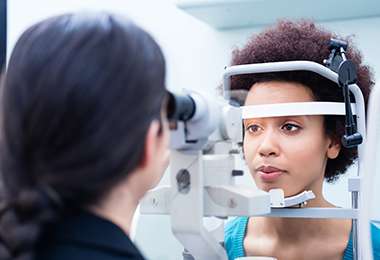
Glaucoma is an eye condition that damages the optic nerve. The damage is usually caused by a buildup of abnormally high pressure in the eye.
The most common type of glaucoma doesn’t come with any warning signs. It occurs so gradually that patient probably will not even notice a change in vision until it has reached an advanced stage.
If glaucoma is caught early, vision loss may be slowed down or even prevented. Glaucoma can cause permanent vision loss. Once glaucoma is diagnosed treatment is usually needed for the duration of the patient’s lifetime.
Glaucoma is caused by damage to the optic nerve. The nerve will progressively deteriorate causing, blind spots. While eye doctors do not fully understand why this happens, they do know that the damage is usually caused by an increased in eye pressure.
The increase in eye pressure is caused by a buildup of the fluid that flows through the eye. The fluid usually drains into the front part of the eye through the tissue where the cornea and iris meet. If the fluid is unable to drain properly or there is an over production of fluid, it cannot drain normally and the eye pressure rises.
Glaucoma tends to be hereditary. Scientists have also identified certain genes that are connected to higher than normal eye pressure and optic nerve damage.
While there are several forms of glaucoma two are seen more often in adults – open-angle glaucoma and angle closure glaucoma.
Open-angle is the most common type of the glaucoma. The drainage angle created by the iris and cornea remains open, however the tissue known as trabecular meshwork is partly blocked. Which causes pressure in the eyes to progressively increase. The pressure causes damage to the optic nerve. This process occurs very slowly, patients may lose their vision before they’re aware there is even a problem with their eyes.
Angle-closure glaucoma, or closed-angle glaucoma, transpires when the iris protuberances forward and causes a narrow or blocked drainage angle. Thus, fluid cannot move through the eye and the pressure increases.
Glaucoma tends to be hereditary. Scientists have identified genes related to high eye pressure and optic nerve damage. Other risk factors include the following:
The eye doctor will dilate the eyes with eye drops. Dilation does not hurt, it simply makes the pupils larger so, the eyes can be examined better. The eye doctor will also check the vision (using an eye chart), and check the eye pressure which is non-invasive and painless. If the eye doctor determines glaucoma is present, photographs may be taken for further examination and to check the progression.
The doctor may prescribe prescription eye drops, recommend microsurgery or laser surgery. Eye doctors generally try the eye drops before any type of surgery. Eye exams are very important, quick and painless because glaucoma usually does not present with any symptoms until the very late stages.
I was very fortunate to have Dr. Haggerty as my doctor. He found a problem with my eyes that a previous doctor had missed, that could have led to blindness. He fixed the problem painlessly and now my eyes are great. He also did an eyelift for me and I can see so much better than before. For me they are the best!!